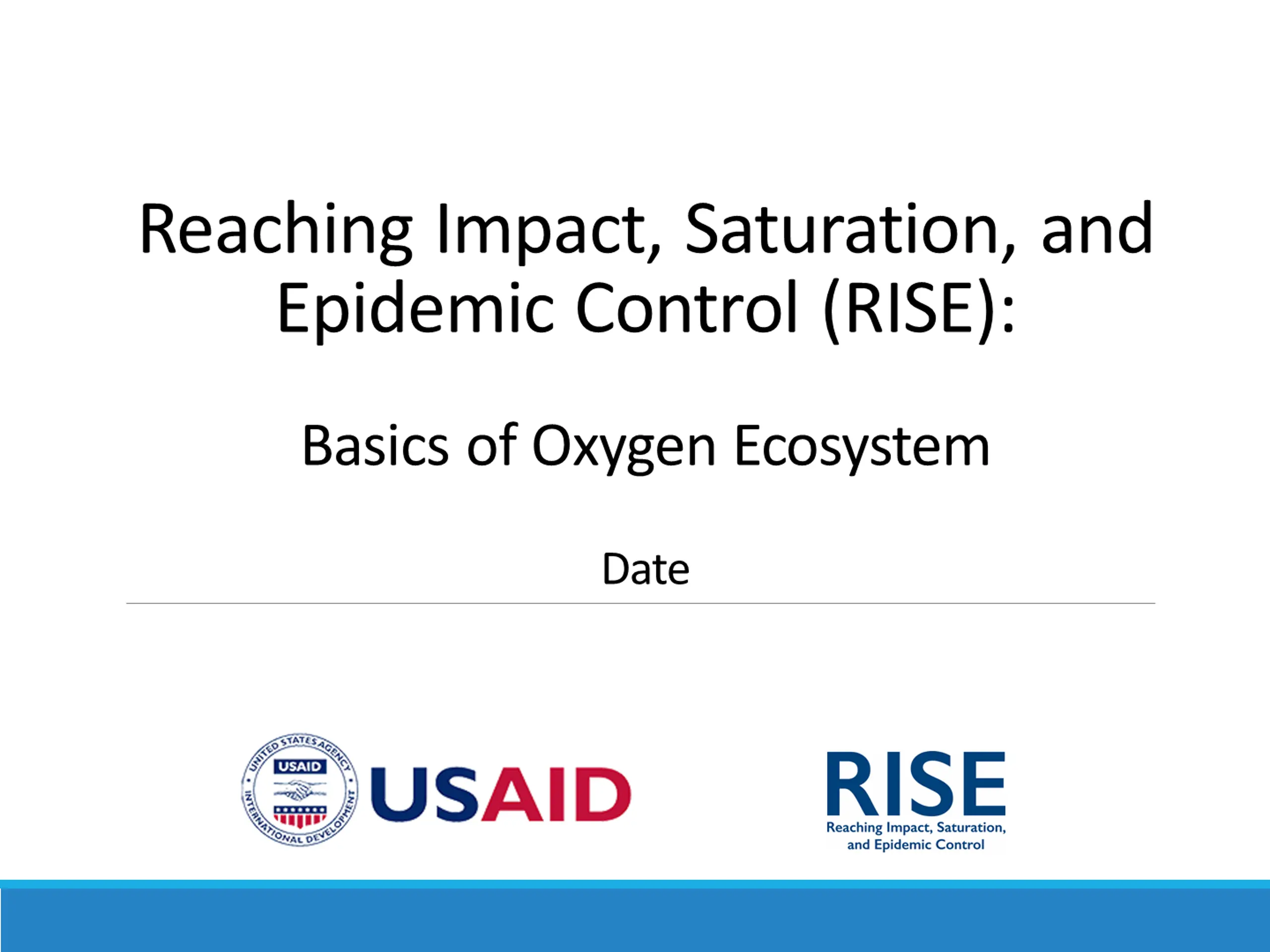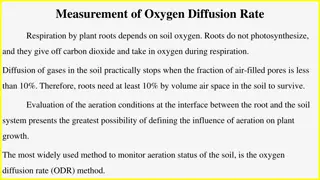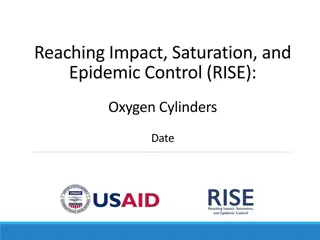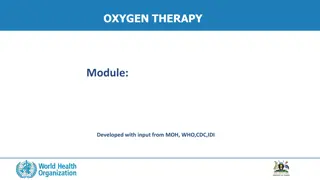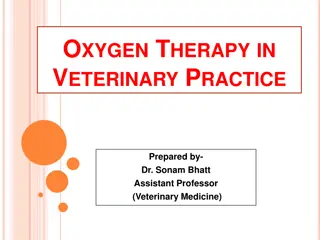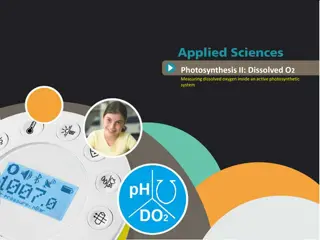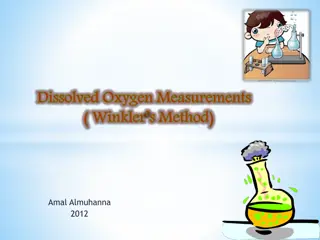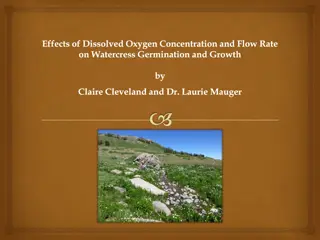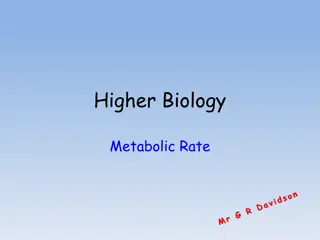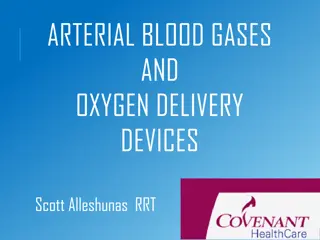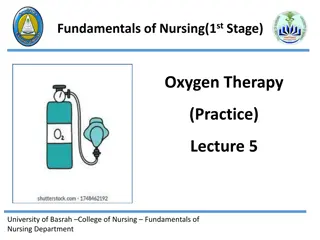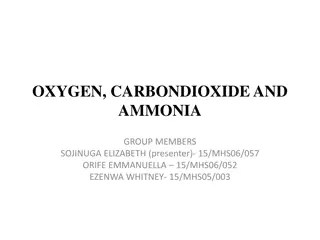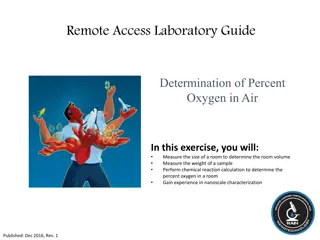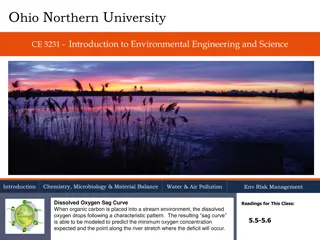Essential Medical Oxygen: Supply and Safety Guidelines
Medical oxygen is crucial in healthcare, especially during the COVID-19 pandemic. This resource explains its importance, use in various treatments, safety measures, and storage requirements. Learn about the significance of high-grade oxygen and the process of oxygen therapy delivery. Enhance your understanding of oxygen's role as a life-saving therapeutic gas in managing hypoxemia and various respiratory conditions.
Download Presentation

Please find below an Image/Link to download the presentation.
The content on the website is provided AS IS for your information and personal use only. It may not be sold, licensed, or shared on other websites without obtaining consent from the author.If you encounter any issues during the download, it is possible that the publisher has removed the file from their server.
You are allowed to download the files provided on this website for personal or commercial use, subject to the condition that they are used lawfully. All files are the property of their respective owners.
The content on the website is provided AS IS for your information and personal use only. It may not be sold, licensed, or shared on other websites without obtaining consent from the author.
E N D
Presentation Transcript
Reaching Impact, Saturation, and Epidemic Control (RISE): Basics of Oxygen Ecosystem Date
Session: Oxygen Therapy REACHING IMPACT, SATURATION, AND EPIDEMIC CONTROL (RISE)
Medical Oxygen Medical oxygen is high purity oxygen that is used for medical treatments and is developed for use in the human body. Oxygen is an essential medicine used to care for patients at all levels of the healthcare system, including in surgery, trauma, heart failure, asthma, pneumonia and maternal and childcare. Oxygen is the most important and essential of the drugs for saving the lives of Covid-19 patients. The COVID-19 pandemic has accelerated global demand for 4 oxygen and made the delivery of oxygen supplies more urgent than ever.
Oxygen is not a flammable gas, but it easily supports combustion An essential medicine required at all levels of the health care system Materials flammable in air will burn vigorously in oxygen Medical Grade Oxygen Oxygen of a minimum 90% purity and free from any contamination Some fuels, such as oil and grease, burn almost explosively when combined with oxygen Only high quality, medical- grade oxygen should be given to patients REACHING IMPACT, SATURATION, AND EPIDEMIC CONTROL (RISE)
Medical Oxygen Usually accomplished by a large storage system of liquid oxygen (minus 180 degree Celsius) at the hospital which is evaporated into gaseous by vaporized supply, pressures around 345 380 55.1 psi) oxygen usually (50.0 are kPa The gaseous oxygen is stored in the cylinders at 2000 psi pressure regulator that allows to reduce the pressure to 50 psi to the patient. with a 6
Oxygen Therapy Oxygen: A life-saving therapeutic medical gas used for managing hypoxaemia Oxygen therapy or supplemental oxygen: oThe provision of medical oxygen as a health-care intervention oAn essential element of basic emergency care oRequired for surgery and the treatment of several respiratory disease Medical oxygen: oat least 90% pure oxygen ofree from any contamination
Where is Oxygen Therapy Needed? PRIMARY LEVEL SECONDARY LEVEL TERTIARY LEVEL (e.g. home, community care, health post, health centre) (e.g. district hospital) (e.g. regional, specialized hospital, specialized outpatient clinics) General ward Labour unit Neonatal resuscitation corner Emergency triage Transport to referral Emergency triage Labour and delivery room Neonatal care Paediatric and/or adult ward ICU Operating theatre Emergency triage Labour and delivery room ICU (neonatal, pediatric, adult) Paediatric and adult wards Surgery and recovery wards Cardiopulmonary ward Emergency ward
Oxygen Ecosystem Regulation and Conditioning Patient Monitoring Oxygen Source Delivery Distribution Concentrator Cylinder PSA/VSA/VPSA Plant Liquid Medical Oxygen (ASU Plant) Central or sub- central piping Transport (for cylinders) Transport (for Liquid Oxygen) Regulator Flowmeter Flowmeter stand (flow splitter) Humidifier (heated and non- heated) Blender CPAP BiPAP Ventilator Nasal cannula Nasal catheter Masks Tubing Non Rebreather Mask Pulse oximeter Multiparameter monitor
Different Sources Of Medical Oxygen Cylinders Concentrators Oxygen plant (PSA) Liquid oxygen Clinical application and/or use case Can be used for all oxygen needs, including- high-pressure supply; facilities where power supply is intermittent or unreliable; ambulatory service or patient transport; backup for other systems. Primary, secondary, possibly tertiary (any medical unit requiring oxygen). Used to deliver oxygen at the bedside or within close proximity to patient areas. A single concentrator can service several beds Can be used for all oxygen needs, including high- pressure supply. Can be used for all oxygen needs, including- high- pressure supply and in facilities where power supply is intermittent or unreliable. Appropriate level of health system Primary, secondary, possibly tertiary (any medical unit requiring oxygen). Secondary and tertiary. Secondary and tertiary.
Side Effects Of Oxygen Therapy Dryness of mucosa due to high flows Elevated PaO2 or hyperoxemia: Increased risk of oReactive oxygen species oAbsorption atelectasis in poorly ventilated areas oRetinopathy of prematurity in newborns oRisk of infection oMortality oIncreased hospital stay
Side Effects Of Oxygen Therapy Coronary vasoconstriction - worsening of Myocardial Infarction Reperfusion injury Increase in infarct size Worsening of stroke False reassurance to the staff Hypercapnia in patients with type 2 respiratory failure
Side Effects Of Oxygen Therapy Shortage of oxygen supply for the most needed person Increased cost of treatment Deaths due to hypoxemia
Side Effects Of Oxygen Therapy Fire hazard
Administration Of Oxygen Oxygen should be administered by trained nursing staff Proper selection of oxygen device Ensure adequate fit to avoid leakage Adjust flow rate to achieve target saturation range Use of closed suctioning device to prevent de-recruitment
Session: Oxygen Delivery Solution REACHING IMPACT, SATURATION, AND EPIDEMIC CONTROL (RISE)
Administration Of Oxygen Oxygen source Oxygen cylinders Wall oxygen Oxygen concentrators Oxygen plants Liquid oxygen Nasal prongs Face mask Partial and non rebreathing masks Hood box Oxygen delivery Low flow systems systems High flow systems Interface Nasal prongs Masks Hood Venturi mask HFNC
Liquid Oxygen Containers Liquid oxygen is stored, shipped, and handled in several types of containers, depending upon the quantity required The types of containers in use include cryogenic liquid cylinder/ DURA cylinder, and cryogenic storage tank Storage quantities vary from a few litres to many thousands of litres (In India IS 7396:2017 is followed) Since heat leak is always present, vaporization takes place continuously Rates of vaporization vary, depending on the design of the container, external temperatures and the volume of stored product Containers are designed and manufactured according to the applicable codes and temperatures and pressures involved Liquid oxygen is a cryogenic liquid, pale blue in colour with a has a boiling point of 297 F ( 183 C). It is a compressed form of oxygen, required to be stored in the vacuum insulated tank much below -200 C, to ensure that the oxygen remains in the liquid form. specifications for the
Cryogenic Liquid Cylinders (Dura Cylinder) Cryogenic liquid cylinders are insulated, vacuum-jacketed pressure vessel They are equipped with pressure relief valves and rupture disks to protect the cylinders from pressure buildup. Liquid containers operate at pressures in the range of 100 psig to 350 psig (24 atm) and have capacities between 80 and 450 liters of liquid Oxygen may be withdrawn as a gas by passing liquid through an internal vaporizer or as a liquid under its own vapor pressure
Cryogenic Storage Tanks Customer installations generally include a tank, vaporizer, and pressure control manifold. Tanks are generally cylindrical in shape and are mounted in fixed locations as stationary vessels or on railcar or truck chassis for easy transportation. All tanks are powder- and vacuum- insulated in the annular space and equipped with various valves to control product fill, pressure build-up, pressure- relief, product withdrawal, and tank vacuum. Tanks are designed to national and international specifications pressures and temperatures involved. for the
LMO- Pros & Cons Pros Liquid oxygen can be stored in a portable tank and connected to a Central pipeline. Liquid oxygen is highly concentrated, so more oxygen can be stored in a smaller tank and ensure continuous supply at high pressure. Most cost-effective system for larger facilities. Cons Liquid oxygen cannot be stored for prolong time because it will vaporize (evaporate) and build-up pressure inside storage tank. The tank's content must be consumed and refilled often, requiring the scheduling of deliveries. The system need PESO license compliance.
Gaseous Oxygen Cylinders Oxygen gas can be compressed and stored in cylinders. These cylinders are filled at a gas manufacturing plant, either via a cryogenic distillation/ASUs in liquid oxygen form or a process known as pressure swing adsorption (PSA) in gaseous oxygen form or by an LMO-based re-filler and transported to health facilities to be connected to manifold systems (groups of cylinders linked in parallel) that are piped to areas of the health facility; or cylinders can be used directly within patient areas. Cylinders do not require electricity, but they do require several accessories and fittings to deliver oxygen, such as pressure gauges, regulators, flowmeters, and, in some cases, humidifiers. Cylinders commonly provided by gas suppliers at the point of refilling. also require periodic maintenance,
Oxygen Cylinder Pros And Cons Pros Cons Installation does not need permission from any authority like Petroleum and Explosives Safety Organization (PESO). Space accommodating as construction is long and linear. Easy setup, can also be used bedside without medical gas pipe system. Recommended as primary source for small size hospital up to 30 beds. Not recommended (specially in current pandemic) as primary source to ICU's. Erratic supply chain. Chances of carrying infection.
Oxygen Cylinder Type B & D B D B-Type Small Medical Oxygen Cylinder (1.5 CU.M.) B-type high pressure seamless cylinder for medical oxygen gas, cylinder is ISI marked conforming to IS:7285 part 2, certified by the Bureau of Indian Standards (BIS) and approved by the chief controller of explosive (CCOE) Government of India. Cylinder made from manganese steel. 10.2 litre. Water capacity (40 cu.ft.). Valve made of brass and chrome plated. Working pressure 150 kg. F/cm at 15 deg. C. Hydraulic test pressure 250 kg. F/cm . Colour code of the cylinder should be as per IS: 3933-1966 with updating till date. Filled with medical oxygen gas of medical grade. Matching key cum spanner to release oxygen for each cylinder separately. Minimum two years guarantee for cylinder. D-Type Jumbo Medical Oxygen cylinder (7 CU.F.M.) Cylinder made from manganese steel. 46.7 Litre. water capacity (220 CU.FT.). Valve made of brass and chrome plated. Working pressure 150 Kg. f/cm at 15 deg. C. Hydraulic test pressure 250 Kg. f/cm . Filled with medical oxygen gas of medical grade. Matching key cum spanner to release oxygen for each cylinder separately. Minimum two years guarantee for cylinder.
Oxygen Cylinder Types Cylinders type (Gaseous Medical Oxygen) Dura Cylinder (Liquid Medical Oxygen)
Medical Gas Pipeline System FUNDAMENTAL PRINCIPLES Standards Designed as per IS 7396, to withstand the pressure at every different section of the oxygen piping system Color Oxygen pipeline in India is covered in White paint Pressure Near the LMO plant : >15 bars Wards and zones : > 5 - 7 bars General delivery : 4-5 bars
Medical Gas Pipeline System FUNDAMENTAL PRINCIPLES Working Oxygen pipeline system should gradually taper. Its diameter should systematically reduce from the oxygen plant to the delivery point Construction Divided the pipeline system into different zones Have pressure gauges to show pressure in the zones Have a master alarm and zonal alarms if there is a drop in pressure
Working Of Manifold Jumbo manifold system has two banks and one reserve bank. Each bank connected to a common header with a separate manifold pressure regulator & and banks alternately supply the pipeline. Manifold system operates on differential pressure mechanism. The automatically when content of the primary bank is exhausted. secondary bank comes into operation Manifold automatically between left bank and right bank. control panel assists in switching Automatic control panel need no power or electricity requirement for operation. In case of power failure, control panel has fail-safe mechanism, if required. Both right and left bank opens in case of power failure and will ensure unobstructed flow to hospital on self- displacement method.
Precautions With MGPS Consult professional designer a biomedical engineer / Do not randomly add ventilators on your existing oxygen piping system Construct a high-capacity oxygen piping from the plant from scratch and take it to the ICU unit Distribute new ventilators across the floor in the different sections of the oxygen piping There should be at least one person at any given point of time who understands the entire oxygen pipeline layout Train and appoint dedicated manpower across all shifts Every ward or every zone should have zone or ward wise drawings of the MGPS with clear indication of pressure settings and valve positions There should be display of the entire oxygen pipeline layout with pressure setting and the valve positions at centrally accessible places in hospitals
Oxygen Concentrators- Patient Delivery Consumables & Accessories Patient Delivery Accessories To deliver oxygen from the concentrator to the patient, oxygen outlet adaptors and oxygen delivery tubing are necessary in addition to replaceable nasal prongs and/or catheters. Accessories to divide flow to multiple patients Flow rate of delivered oxygen must be continuously adjustable by the user FLOWMETER STAND Necessary because oxygen flow needs require adjustment over the course of treatment, particularly important for premature newborns in whom excessive oxygen therapy causes harm Patients are started at different flow rates depending on their age, clinical condition and the type of breathing device used REACHING IMPACT, SATURATION, AND EPIDEMIC CONTROL (RISE)
A four-way flow splitter assembly has been used as a method to split flow. It consists of a four-way flow splitter block, nozzles for 0.5, 1 and 2 LPM and blanking plugs. Flow splitters are less preferred than flowmeter stands or built-in pediatric flowmeters, since the corresponding blanking plugs are very easily lost or misplaced. Flow splitters use nozzles that deliver FLOW SPLITTER, NOZZLES AND BLANKING PLUGS oxygen at a single fixed rate. REACHING IMPACT, SATURATION, AND EPIDEMIC CONTROL (RISE)
Simple Oxygen Patient Delivery Interface Equipments Non-rebreather mask (NRBM) can deliver higher concentrations of oxygen than cannula and regular mask Oxygen cannula prongs that are placed in the nose for providing oxygen to patient Oxygen mask covers lower part of face Exhaled air exits through 1 way valves thus preventing any rebreathing of exhaled air or room air
Higher Flow/Complex Oxygen Patient Delivery Equipments High flow nasal cannula Invasive mechanical ventilation Specialized cannula designed to provide oxygen up to 60LPM and limit inhalation of room air Through intubation, oxygen is pumped into a patient s lungs
Humidifiers There are various types of humidifiers, and their designs differ in how they apply three main principles : Oxygen humidifiers are medical devices that can be integrated into oxygen delivery systems to humidify supplemental oxygen. 1. Temperature: As the temperature of gas increases, its ability to hold water vapour increases. Humidification is not necessary when oxygen is delivered at relatively low flow rates through nasal prongs or nasal catheters 2. Surface area: There is more opportunity for evaporation to occur due to greater surface area of contact between water and gas. When oxygen is delivered at higher-than- standard flow rates, or when methods of oxygen delivery bypass the nose, such as when nasopharyngeal catheters are used, humidification is needed especially when cold oxygen is delivered from a cylinder. 3. Time of contact: There is more opportunity for evaporation to occur when a gas remains in contact with water for long duration.
Types Of Humidifiers Bubble humidifier Non heated (reusable) Bubble humidifier Non heated (single use) Bubble humidifier heated Description A reusable bottle that reduces the dryness of oxygen by bubbling the gas through distilled water (or water that has been boiled and cooled) at room temperature. A single-use bottle that reduces the dryness of oxygen by bubbling the gas through distilled water at room temperature. A device consisting of a heat source and a humidification chamber whereby the built-in heater warms the water in the chamber to add moisture to the airstream as it passes over the surface. Merits Simple. No power required. Low cost. Reusable. Simple. No power required. Low cost. Reusable. Adjustable heat for more or less moisture. More efficient at humidifying gas. Drawbacks High risk of contamination (reduced by changing the water frequently) Decontamination required Disposable/single-use. More costly. Risk of rainout . High risk of contamination (reduced by changing the water frequently). Needs power source. General Comments Works best at a water temperature of at least 30 C. Works best at a water temperature of at least 30 C. Works best at a water temperature of at least 37 C.
Oxygen Delivery Devices FiO2: Fraction of inspired oxygen
Oxygen Delivery Devices o Low flow (Variable performance devices) Nasal cannula (prongs or spectacles) Nasal catheters Transtracheal catheter Face mask Simple face mask Partial rebreathing mask Non rebreathing mask Tracheostomy mask o High flow (Fixed performance devices) Venturi mask (HAFOE) Aerosol mask and T-piece with nebulizers o Reservoir system (Variable performance device) Reservoir cannula
High Flow Devices Air Entrainment Mask (Venturi) High Flow Nasal Oxygen Therapy/ High Flow Nasal Cannula NIV (Non-invasive ventilation) Masks HAFOE (High air flow with oxygen enrichment mask) systems Anesthesia circuits Ventilators Non-invasive Invasive
Selection Of Oxygen Device Depends on Age of the patient Oxygen requirements/therapeutic goals Patient tolerance to selected interface Need for humidification
Monitoring Continous monitoring of SpO2 using pulse oximetry Pulse oximeter should be available wherever oxygen is used Titrate FiO2 and flow of oxygen carefully based on SpO2 Record SpO2 on patient chart along with other vital signs Educate patient about the importance of proper delivery of oxygen Monitoring of arterial blood gas wherever indicated
SAVE OXYGEN!! 30% - 40% REACHING IMPACT, SATURATION, AND EPIDEMIC CONTROL (RISE)
Thank You! This presentation was made possible with support from the United States Agency for International Development funded RISE program, under the terms of the cooperative agreement 7200AA19CA00003. The contents are the responsibility of the RISE program and do not necessarily reflect the views of USAID or the United States Government.
